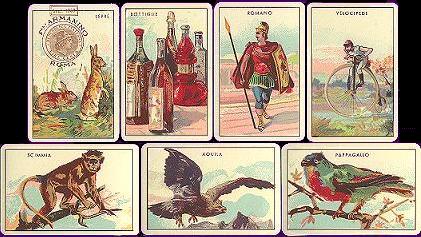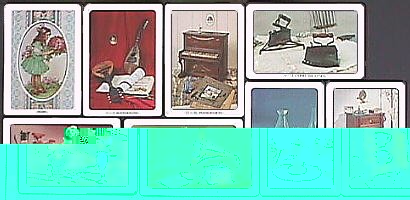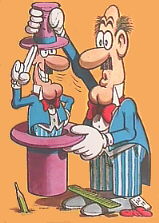This gallery is dedicated to the special sets used for a traditional Italian family
game, usually played over the Christmas holidays.

MERCANTE IN FIERA CARDS


edition by Armanino: sample subjects and detail
of the Turk
Mercante in Fiera (literally Merchant at the Fair)
is a very popular game, played with peculiar illustrated cards.
Each set consists of two decks, with 40 different pictures each; the illustrations
are repeated in both packs, but their backs are of different colour (as in Bridge sets).
What makes these cards nice to collect is that most subjects vary from
manufacturer to manufacturer, and although a few subjects are found in
more than one edition, their illustrations are quite different. |

traditional illustrations in Modiano's classic edition |

the Pagoda,
from Modiano's edition |
In traditional sets, the pictures are inspired
by nature or by everyday's life: subjects can
be animals, or flowers, or fruit, or household objects, or pieces
of furniture, etc.
Since the game is usually played by children, some recent sets feature
illustrations inspired by Disney cartoon movies (two of them are
shown at the bottom of the page).
In modern editions each subject is usually numbered, from 1 to 40,
so that players may refer to each card either by means of its name or its
number, but older sets, such as the one by Armanino shown above, lacked this
additional and rather useless detail.
Prior to 1972, Mercante in Fiera decks had to bear a tax stamp, as any
other variety of playing cards did, in Italy. One of the subjects (card no.1 in editions
with numbers) had a small empty circle for this purpose, but only one of the
two identical cards was stamped. Among the editions now produced, only
the classic one by Modiano has maintaind the small circle.
|
Mercante in Fiera is a sort of mild gambling game, merely based on luck,
by which kids and adults alike can play with equal opportunities of winning. More than the
prize itself, the real fun of the game is playing it, because of its particular
structure.


reprint by Lo Scarabeo of an early 20th century edition
At first, the players must decide who will be the
merchant of the round, either choosing
him at random or by agreement.
The merchant is the player who in in charge for
the main operations; he has a more limited chance of winning than the other players,
but he leads the game, and this can be very amusing all the same, as will be explained
further on.
After the two decks have been well shuffled, each player pays a small sum to enter the
game. The merchant then picks up the first deck and deals two cards
to each player, who will place them face up in front of himself. |

Mercante in Fiera deck, by Italcards;
the subjects feature old household objects |

the Coffee-grinders, from Italcards' deck |
Usually the
merchant too enters the game by paying his fee, and deals two cards to
himself.
The following step is the auction. The merchant sells small groups of
cards (usually one to four at a time, but he can freely choose how many), using
the remaining part of the deck from which the first ones have been previously
dealt.
The merchant does this operation holding the deck under the table, so
that other players do not know how many cards they are bidding for. |
Each time, the
merchant decides the opening price, and the players are
free to place their bids. There is no fixed rule for this: each player is free
to offer as much as he likes, and to do so as many times as he
wishes.

an edition by Masenghini, with traditional subjects |
Once a group of cards has been sold, and the payment collected
by the merchant, another group of cards will be auctioned, and so on until
the whole first deck has been sold out.
When a player buys some cards, he places them face up in front of himself,
together with the first two he already holds. |
|
There is no limit to the number of cards a player may buy. The more he holds,
the higher will be his chance to win a prize, but with a little luck
even the two starting cards alone may win. |
|

Crane, first subject
of Masenghini's edition |

a recent edition by Modiano, with 55 subjects per pack instead of the
traditional 40; the manufacturer's own label (the Modiano king,
last card in the bottom row) is the last subject of the series
Usually the merchant is not allowed to place a bid,
because he knows how many cards are in the groups he is selling, so he plays the
game by only keeping the two cards dealt at the beginning of the round.
A common agreement is that when the last group of cards is auctioned,
the merchant should give notice of this to the players, by calling
"last cards". |
As soon as all the cards have been sold,
the merchant shuffles well once again the second deck. He then asks
any of the other players to randomly pick three cards, that will be set aside,
and kept well covered: these are the winning cards of the round.

the Astronomer, from Modiano's
55-card edition, illustrated with
19th century-style engravings
|

the edition by Dal Negro is another one with traditional
pictures; some of the subjects are in common with
Modiano's set, but their illustrations are different |
According to the money raised with the
auction, the merchant agrees three different prizes with the other players:
a larger sum as first prize, a proportionally smaller sum as second prize, and
the smallest one as third prize; the money is actually placed
over each winning card (still kept face down).
The merchant then begins to uncover one by one all the remaining cards
of the second deck, calling out the name of the subject, and eventually its
number: the player who holds the matching card has to cover it, or simply
discard it. |
As the cards in the second deck are gradually
called out, the remaining ones still held in hand by the players become more and
more likely to be the winning ones; the owner can decide to keep them,
or even to sell them, if offered a reasonable sum by any other player.
Approaching the end of the round, the value of the cards still uncovered will
obviously grow.
As soon as all the cards in the second pack have been called out, the players holding
the three surviving cards claim their prize: the three winning cards
are finally uncovered (usually starting from the lowest prize, then the second
one, and lastly the first one), and the money is handed to the winners. |

the Musketeer,
from Dal Negro's edition |

Viassone's edition
detail of Armor |

in Viassone's Mercante in Fiera the subjects
are photographs of famous buildings, fruit, animals... |
Being a family game, some of the rules may be changed: a bidding limit
may be agreed by the players, or the number of cards sold in each group may be fixed, or
the number of prizes into which the money is divided may be varied according to the
sum raised, etc.


the pictures of this set, by Modiano, were drawn by the popular Italian
cartoonist Jacovitti: the cards feature his typical surrealistic characters

Mercante in Fiera deck with traditional Walt Disney
characters; the manufacturer is not stated |
The key to a good game is to choose an experienced "merchant": he can
make the auction exciting, by alternating the number of cards sold in each group, so that
he will obtain good bids even for groups of one or two cards. Then, during the second
part of the game, instead of calling out the cards straight away, he will use personal
techniques to stir up the players interest (i.e. for a card like "the Dog", he might start
asking "Who's got animals? Here is one with four legs... Is anybody selling his cards?",
etc.). |
Also other players can take active part to the game, as they are left free to trade and
sell one or more cards they own, during any part of the game. Obviously, only chance will
decide the winning cards, but since players very often like to consider some subjects lucky
or unlucky, or simply like or dislike them on a very personal basis, a fair amount of trades
often takes place during the game, especially during the early and central stage of the round. |

a Mercante in Fiera deck dedicated to
Walt Disney's cartoon Hercules (by Dal Negro) |

Medusa, from the Hercules deck |
There is no limit to the number of players who can take part to the game,
but good rounds are played by no less than 6 people.
According to the number of players, it is possible to vary the quantity of cards dealt by the
merchant at the opening of the game: the average is two, but when a large party of people is
playing, it will be better to deal only one, so to keep enough cards for the auction.
|


Esmeralda (in detail) and other subjects, from Dal Negro's edition
dedicated to Walt Disney's cartoon the Hunchback of Notre Dame
Despite being specifically used for a family game, up to 1971 also Mercante in Fiera decks had to carry a tax stamp, as any other kind of playing cards in Italy. In fact, in most cases one of the subjects, usually the first one of the series, had a white blank circular space, which in some editions has been maintained. If a space was not available, the stamp was placed over the subject, as in the sample shown on the far left, by Dal Negro.
Only one card in each Mercante in Fiera set was stamped: the same subject belonging to the other deck (i.e. with a different back) was not stamped. |
 |
OTHER PAGES IN THIS SECTION
OTHER GALLERIES






















or back to

INTRODUCTION
AND HISTORY
|

MULTI-LANGUAGE
GLOSSARY |

THE FOOL &
THE JOKER |

INDEX
TABLE |

REGIONAL
GAMES |

PLAYING CARD
LINKS |






















